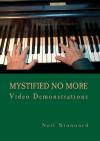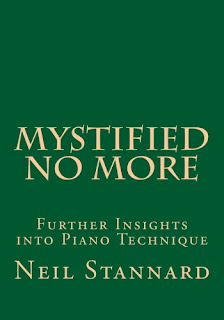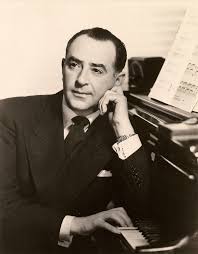Offered now for the first time on DVD, are the mini-lessons, the technique demonstrations heretofore available only on YouTube. Find them first at CreateSpace; they will soon be at Amazon. This re-imagined and re-recorded no-frills collection of technical illustrations gets right to the point of each of the indicated musical examples in the book, "Piano Technique Demystified: Insights Into Problem Solving." Plus, this DVD includes additional demos not available on YouTube, including illustrations of selections from Chapter 30, "Fifty Teaching Moments." There is also a bonus preview of the sequel, "Mystified No More DVD" on the subject of Chopin's Etude Op 10, No. 3, the treacherous middle section. Watch the entire 84 minutes through, or skip around by chapters. Finally, a resource to hold in your hand and store for future use. No more dependence on the fragility of the internet.
Playing the Piano is Easy and Doesn't Hurt! Learn how to solve technical problems in Bach, Mozart, Beethoven, Chopin and all the other composers you want to play. Reconsider whether to spend time on exercises and etudes or music. Discover ways to avoid discomfort and injury and at the same time increase learning efficiency. How are fast octaves managed without strain? How are leaps achieved without seeming to move? And listen to great pianists of the past.
“Music is a moral law. It gives a soul to the universe, wings to the mind, flight to the imagination, a charm to sadness, and life to everything. It is the essence of order, and leads to all that is good, just and beautiful, of which it is the invisible, but nevertheless dazzling, passionate, and eternal form.” Plato
Tuesday, May 17, 2016
New DVD: Piano Technique Demystified iDemos (and More)
Offered now for the first time on DVD, are the mini-lessons, the technique demonstrations heretofore available only on YouTube. Find them first at CreateSpace; they will soon be at Amazon. This re-imagined and re-recorded no-frills collection of technical illustrations gets right to the point of each of the indicated musical examples in the book, "Piano Technique Demystified: Insights Into Problem Solving." Plus, this DVD includes additional demos not available on YouTube, including illustrations of selections from Chapter 30, "Fifty Teaching Moments." There is also a bonus preview of the sequel, "Mystified No More DVD" on the subject of Chopin's Etude Op 10, No. 3, the treacherous middle section. Watch the entire 84 minutes through, or skip around by chapters. Finally, a resource to hold in your hand and store for future use. No more dependence on the fragility of the internet.
Friday, May 13, 2016
Piano Technique in a Nutshell
It occurs to me that in this age of IM's and Tweets a simple and direct message might be just the thing. Here it is: Departure, arrival, conveyance. Notice the travel lingo. An efficient piano technique relies on an understanding of how to get from
one position on the keyboard to another. It's almost that simple. When there's a problem, notice first where you are. Then, find out where you want to be. Finally, figure out how to get from point A to point B.
Ah, you say, "the getting there," that's the rub. Those readers who also play string instruments will be way ahead of me. This
"getting there" is like shifting on a fingerboard from first position to second, or from first position to fifth or higher—which can be made to sound scrumptiously expressive, especially with the addition of a tasteful, angelic portamento. But I digress.
We're talking about the technical grouping of notes. Notes that fall more or less under the hand are, for our purposes, a group. This could be a five-finger pattern—plus or minus. The connection to a subsequent group can be accomplished in two ways, either by means of a thumb-crossing or a leap. In the first case, the thumb is the conveyance, which in my approach is accomplished with a rotational gesture. (Look in the iDemo Tab for a video demonstration.) If the connection requires a leap, that is from one spot on the keyboard to another by means of finger to finger action, not requiring the thumb, the trip is accomplished by means of a plucking or springing gesture in combination with a rotation. The pluck gets the distance; the rotation (and gravity) produce the arrival. (Look for a demonstration in the iDemo Tab under leaps.)
So, in a nutshell, the last note of the first group always—and I never use the word always or the word never, so this is important—the last note of the first group always conveys the hand/finger/forearm collaboration to the first note of the next group. Last note to first note. There. Isn't that easy? Or at least succinct?
Of course, the notes in each group, that is, the notes "under the hand," may require some technical assistance. But that's another topic.
Wednesday, May 4, 2016
Beethoven Sonata Op. 28 and the Drama of the Small Hand
 |
| Beethoven c. 1801 |
My student of the small-hand persuasion brought the first movement of Beethoven's sonata number 15, the ever so placid "Pastorale" sonata (1801). Virtually nowhere in this generally lyrical sonata do we hear anything of the brooding that would seem reasonable just a year before that fateful fall of 1802, the fall of the Heiligenstadt Testament: As the leaves of autumn wither and fall, so has my own life become barren: almost as I came, so I go hence. Even that high
courage that inspired me in the fair days of summer has now vanished. We are so fortunate that Beethoven chose to remain among the living to fulfill his destiny.
 |
| Heiligenstadt Testament autograph |
For my student, the sonata was anything but placid, technically at least. She complained of feeling stretched in the gently undulating Alberti figures that outline octave positions. And her primary reason for taking this piece was to avoid octaves!
As always, I listened attentively. Over the years, I've learned that it's best to first let the student vent, even though I knew immediately what the problem was and how to fix it.
This is a grouping issue, even in a normal-sized hand. On the third beat of measure one, release the eighth (thumb) D and feel (not hear) a new start from second-finger G-sharp, which serves as a hinge, a pivot point. There will also be a slight up on the second finger to down on the heavier octave. On the final quarter of measure two, I release the fifth-finger D because that 5th-finger next to 2nd-finger E creates too much of a stretch. Proceed in similar fashion. Voila. This avoids that uncomfortable feeling of staying open in an octave position. Discreet use of the pedal aids in maintaining the legato.
 |
| Beethoven Op. 28, first movement, mm 88-96 |
Saturday, April 9, 2016
Mystified No More DVD Coming to Amazon
 |
| Mystified No More DVD |
Offered now for the first time on DVD are the mini-lessons, the technique demonstrations heretofore available only on YouTube. Some of my readers have asked for such a thing, but the production cost and logistics have until now proven close to insurmountable.
 This no frills collection of technical illustrations gets right to the point of each of the indicated musical examples in the book, Mystified No More: Further Insights into Piano Technique. Watch the entire 69 minutes through, or skip around by chapters. Finally, a resource to hold in your hand and store for future use. No more dependence on the fragility of the internet. And who knows how long the YouTube account—or, for that matter, this blog account—will be active. The DVD is available at CreateSpace now, and soon it will be available at Amazon.
This no frills collection of technical illustrations gets right to the point of each of the indicated musical examples in the book, Mystified No More: Further Insights into Piano Technique. Watch the entire 69 minutes through, or skip around by chapters. Finally, a resource to hold in your hand and store for future use. No more dependence on the fragility of the internet. And who knows how long the YouTube account—or, for that matter, this blog account—will be active. The DVD is available at CreateSpace now, and soon it will be available at Amazon.Thursday, March 10, 2016
Chopin's Sixth Prelude: Dream Cello
Yesterday I found myself demonstrating for a student Chopin's dreamy "cello" prelude, number 6 from opus 28. The challenge here for pianists lies in the disparity between the two hands, coordinating a vertical, gently throbbing right hand with the long horizontal lines in the left, perfectly encompassing the cello range.
"Show me why it's a cello prelude," he demanded.
"I just did," I responded glancing up from the piano in time to see him pointing toward my cello in its cradle at the foot of the piano.
"No, show me on your Strad."
"Shhh," I responded. "Don't say that out loud." I often referred to my Man Claudiu cello from Stringworks as a Stradivarius, sent to me by mistake, and I didn't want them to take it back. This cello has become such an integral part of my daily routine that I couldn't bear to part with it. Claudiu carved my cello himself in Italy from elderly spruce and maple, to which he added a light antiqued oil varnish. I'm sure he harvested his materials from the same Italian Alps as did the great Cremonese master.
My student had a point. Why not show him what we as pianists try to imitate. My Claudiu has a very complex, rich sound, but as I began to play I saw on my student's face an expression very near a scowl. I couldn't have been that bad.
"I can't even come close," he said. "It's such a singing sound, and when you change registers, well it's all of the same fabric. And legato!"
Ah, yes. There's the rub. On the piano we can only create the illusion of legato by carefully placing each note in dynamic relation to the preceding one. I told him not to despair. We make up for our deficiencies in the legato department by getting to be the complete orchestra.
This was a lesson well-learned; there's something to be said for imitation. When he finished playing he looked longingly at the Claudiu. "Do you think Stringworks would send me a Strad by mistake, too?"
"Show me why it's a cello prelude," he demanded.
 |
| Man Claudiu cello from Stringworks |
"No, show me on your Strad."
"Shhh," I responded. "Don't say that out loud." I often referred to my Man Claudiu cello from Stringworks as a Stradivarius, sent to me by mistake, and I didn't want them to take it back. This cello has become such an integral part of my daily routine that I couldn't bear to part with it. Claudiu carved my cello himself in Italy from elderly spruce and maple, to which he added a light antiqued oil varnish. I'm sure he harvested his materials from the same Italian Alps as did the great Cremonese master.
My student had a point. Why not show him what we as pianists try to imitate. My Claudiu has a very complex, rich sound, but as I began to play I saw on my student's face an expression very near a scowl. I couldn't have been that bad.
"I can't even come close," he said. "It's such a singing sound, and when you change registers, well it's all of the same fabric. And legato!"
Ah, yes. There's the rub. On the piano we can only create the illusion of legato by carefully placing each note in dynamic relation to the preceding one. I told him not to despair. We make up for our deficiencies in the legato department by getting to be the complete orchestra.
This was a lesson well-learned; there's something to be said for imitation. When he finished playing he looked longingly at the Claudiu. "Do you think Stringworks would send me a Strad by mistake, too?"
Thursday, March 3, 2016
Looking Back: Jakob Gimpel
If you have been following this blog, you will know that I hold in high regard artists of the past. It is on their shoulders we all stand. If nothing else, we can sometimes amuse ourselves by making connections, discovering stylistic trends or just enjoying remarkable playing—marveling at great facility captured before modern recording techniques began to homogenize taste.
Polish pianist Jakob Gimpel studied with Eduard Steuermann, who was a pupil of Ferruccio Busoni, and Alban Berg. Berg! He made his debut at the age of 17 performing Rachmaninoff's second concerto in Vienna with the Concertgebouw Orchestra, conducted by Pierre Monteux. In the 1930s he emigrated to America for the usual reasons, settling in Los Angeles. In addition to concertizing and teaching, he recorded tracks for classic films such as "Gaslight," "Possessed," "Letter from an Unknown Woman," "Strange Fascination," "Three Stories of Love," and, in his later years, "Mephisto Waltz." There were also two classic cartoons: "Rhapsody Rabbit," in which he played a comically disrupted version of Liszt´s Second Hungarian Rhapsody, and the Academy-Award-winning "Johann Mouse," in which a virtuoso Tom played Gimpel's paraphrase of the "Blue Danube" while Jerry danced.
In the link below Gimpel plays Liszt's "Waldesrauschen" and "Un Sospiro." Oh, did I say? He was one of my teachers at USC, and an inspiring one at that. His performance of Brahms' D Minor Concerto with the University Symphony was definitive. He took over Muriel Kerr's class after her sudden death the night before registration for the fall semester of 1963. One of my lessons occurred on the day JFK was shot, at the time news had just made it to campus. I found Gimpel in tears, beside himself with anguish. Needless to say, our lesson fell to the side, and Gimpel began to relate his personal experiences of extreme politics, which included a hair-raising account of how he and his brother, the noted violinist Brontislaw (student of Carl Flesch and one-time concert master of the Los Angeles Philharmonic), escaped from Europe at the start WW II.
I find these Liszt performances notable for their directly expressive, no-nonsense approach. Notice how his hands move with fluidity and flexibility, a practice I now refer to as shaping. Notice, too, that with such large hands he could get away with fingering octaves, a practice I don't recommend—ever, for any reason. Period. I never heard him complain of discomfort, although in those days performers didn't speak of such things. His technical advice to me was to play honestly, which I now realize was his way of telling me to work for technical ease, in addition to precision. He had about him a certain warmth of expression, and in his manner what I would describe as old world charm. One doesn't find that much these days.
Gimpel Plays Liszt
 |
| Jakob Gimpel |
 |
| Franz Liszt |
I find these Liszt performances notable for their directly expressive, no-nonsense approach. Notice how his hands move with fluidity and flexibility, a practice I now refer to as shaping. Notice, too, that with such large hands he could get away with fingering octaves, a practice I don't recommend—ever, for any reason. Period. I never heard him complain of discomfort, although in those days performers didn't speak of such things. His technical advice to me was to play honestly, which I now realize was his way of telling me to work for technical ease, in addition to precision. He had about him a certain warmth of expression, and in his manner what I would describe as old world charm. One doesn't find that much these days.
Gimpel Plays Liszt
Subscribe to:
Posts (Atom)




